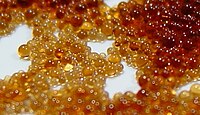
Photo from wikipedia
Abstract This research aimed at selective removal of Pb++ from polluted waters by cation exchange resin in Ca++ form, and regeneration with a novel process using Ca(NO3)2. This process brings… Click to show full abstract
Abstract This research aimed at selective removal of Pb++ from polluted waters by cation exchange resin in Ca++ form, and regeneration with a novel process using Ca(NO3)2. This process brings together remarkable advantages: selectivity, sustainability, economy, safety, simplicity and applicability. The main findings of this study were the selective and efficient removal of Pb++ by a conventional cation exchange resin Purolite C100E, the utilization of Ca(NO3)2 for regeneration, and the purification treatment of regeneration effluents for Ca(NO3)2 total recycling. Indeed, the selectivity and the regeneration are explained by the well-established fixation order: Pb++ › Ca++ › Cu++ › Mg++ › K+ › Na+ › H+; Ca(OH)2 was used to precipitate Pb(OH)2 and to recover Ca(NO3)2. The effects of pH, flow rate, resin bed height, Pb++ initial concentration and Ca++/Pb++ ratio have been systematically investigated and optimized in a column system. The effect of Ca(NO3)2 concentrations was also studied for regeneration and optimization. The process efficiency was always higher than 90% for, both, exhaustion and regeneration. The results show the maximum Pb++ removed was observed at pH range from 2.4 to 4.8, and increases with increasing of resin bed height but decreased as flow rate increased and that effective regeneration (90%) was achieved by 2 mol/L of Ca(NO3)2.
Journal Title: Hydrometallurgy
Year Published: 2018
Link to full text (if available)
Share on Social Media: Sign Up to like & get
recommendations!